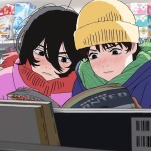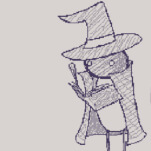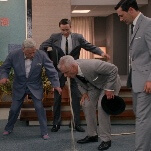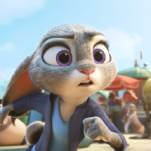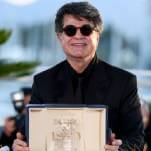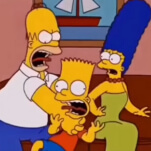Begun as a self-published comic by Groening in 1978, Life In Hell eventually landed as a weekly strip in LA Weekly beginning in 1980. The strip revolved primarily around anthropomorphic rabbit Binky, his girlfriend Sheba, his illegitimate son Bongo, and the pint-sized, fez-wearing couple Akbar and Jeff. (“Brothers or lovers or both, whatever offends you most.”) All told, Groening drew 1,669 strips, which have been collected in more than a dozen books. The strip was also the genesis of what would become The Simpsons; it gained the notice of producer James L. Brooks in the mid-’80s. When Brooks approached Groening about animating bumpers for The Tracey Ullman Show, Groening decided to create new characters rather than use the ones from the strips out of fear of losing creative control over them.
At the height of the strip’s popularity, it appeared in close to 400 papers, but with more and more indie papers folding or cutting their comics content for budget reasons, that number has dwindled to 38. Even its original home, LA Weekly, cut the strip for budgetary reasons in 2009. Groening elaborated on the strip's longevity in an interview with Rolling Stone:
When I started doing the comic strip, it was a great forum for all of my creativity. I’d think about the comic strip all week, spend a day drawing it, and then start thinking about the next one. It was my complete and total focus. Then The Simpsons came along to preoccupy me, and I decided to see how long I could keep the comic strip going. Actually, a TV producer sneered at the strip and said, “Why do you bother? Give it up.” Because of that, I dug in my heels and kept it going two decades longer than I might have. I also liked the idea of having one slice of my creative output being completely solo, unlike TV animation. It’s very satisfying to sit down at a drawing table by yourself and solve a puzzle with a deadline.
That said, Groening’s TV projects clearly took a toll on the strip. In the early years, each installment of Life In Hell was a monumentally dense box of crammed-in text and images, often arranged around a theme; over the decades, it evolved into a much more breezy format, usually involving a single gag, or a single panel. “I will not phone it in,” Groening guiltily resolved in one New Years’ resolution strip, with a tiny, telling drawing of Akbar/Jeff. But it’s no surprise that Groening had a different outlook on life when he was a recent college graduate and struggling artist in the ’70s than he did once he became a millionaire TV producer and a family man; under the circumstances, it’s hard to argue that life is still hell, and Life In A Pretty Awesome Place, Actually doesn’t sound like a particularly trenchant comic.






